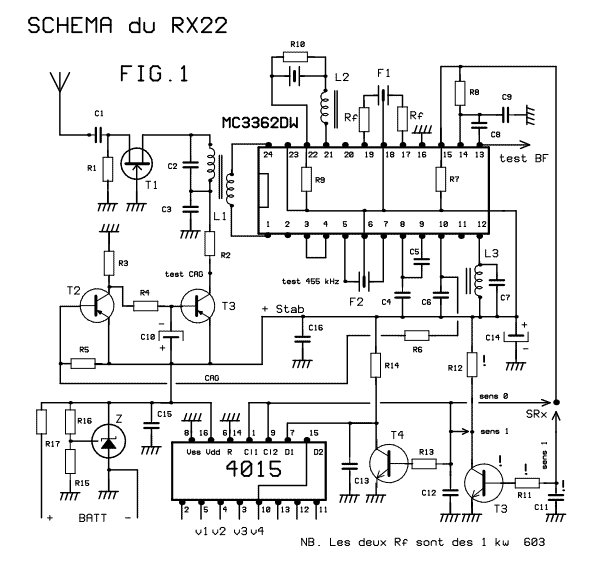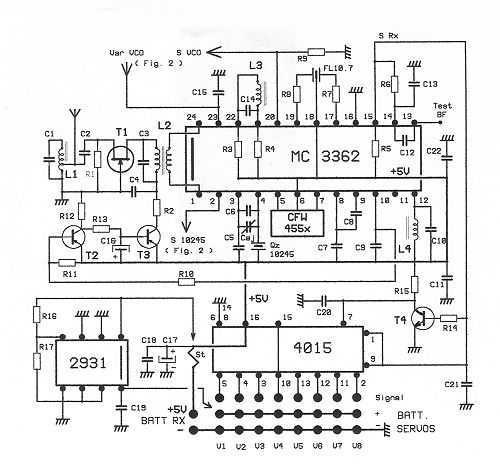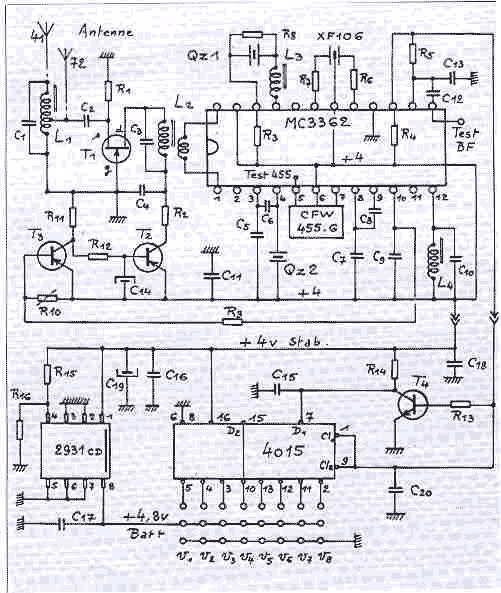
41-72MHz micro-receiver ( MC3362 )

This receiver weighs about 6 g, used in 41 and 72 MHz, met a great success with readers of the magazine. The RX22 is the subject of these lines is improved RX20. Adding a preamp-HF improving sensitivity. Establishment of an automatic gain control of this amp. Integrated voltage regulator. Power Connectors and embedded servos. Using a MC3362DW much easier to find. We therefore returned to the MC13156 MC3362 because is very difficult to find and we seemed a bit risky handling fragile. The MC3362 is actually expected to double the frequency change but here we use simple changer. More: The FET T1 is the HF amplifier. The signal pre-selected by L1 is injected in the first changer of 3362. Associated with the internal oscillator driven Qz, it provides the 455 kHz on the stud 19. Filtering by F1 and reinjection of 17 in the second changer, who here does not change anything because we do work as an amplifier by neutralization of the second local oscillator. Amplified output of 455 kHz to 5. Second filter F2. Reinjection into 7 in the logarithmic amplifier internally. Finally the FM demodulation quadrature using L3 for modulating the signal output 13 (BM test). This AF signal is then applied to the input of a comparator 14 whose output 15 provides the sequence formatting (SRX) and thus usable by the decoder. The logarithmic amplifier also delivers a current proportional to the collected field. (RSSI) The current from 10 is amplified by T2 and T3. It tends to block the supply of T1. Strong signal on the voltage on R2 is zero and T1 operates as an attenuator. Low signal on T1 and T3 leads amplifies. Dynamics of CAG is about 20 dB (factor of 1 to 100). INDOOR a dedicated receiver, this feature seems very important and that's why we wanted to include it. In fact, modelers use to the flight room issuers that are so typical way too powerful. If you're flying alone, it's perfect, but several potential interference by intermodulation are great, as this is a high level that it occurs. In fact, not only requires special receivers for indoor but it would also be useful to have ALL of the transmitters adapted. As it is not feasible, the CAG RX22 is an excellent parade. Click to download the file. pdf Schema It is not enough to remove components to make a good indoor RX (to light, of course!) It would be too easy! We have recently seen a German description where the author removes even IF filters! This is absurd! Conclude the review of the scheme RX22: The decoder has remained one of the RX20 with possibility to work in the direction 0 (THOBOIS) without mounting T3, C11, R11 and R12, or counterclockwise 1 (other) with these components. While delivering the 7 or 8 channels RX22 actually never leaves only 5 connectors, which seems sufficient indoors and even on some others. Finally, note the voltage regulation by programmable zener (Z, R15, R16, R17) delivering a little less than 4 V. This avoids interference during calls current servos. A final word on the quartz QZ. The MC3362 requires an oscillator crystal cut to part 3, that is to say 1 / 3 of the desired frequency but the harmonic oscillating directly to 3, so the expected value. However with such a quartz "standard" provided by the frequency 3362 kHz is 2.5 too low, which gives 457.5 kHz and 455 kHz of not. It follows a loss of sensibility through the filters F1 and F2. To overcome this defect we have defined with a quartz MATEL correct. This will be the RX22-4 for 41 MHz band and the RX22-7 for 72 MHz. The crystal is encapsulated in housing subminiature HC45 / U Only drawback: the price for a command unit. Alas nothing is perfect!
The RX22 receiver is a compact device optimized for operation in the 41 MHz and 72 MHz bands, making it suitable for various applications, particularly in indoor environments where interference can be prevalent. The design builds on the previous RX20 model, enhancing its capabilities with a high-frequency (HF) preamplifier to improve sensitivity and the addition of an automatic gain control (AGC) circuit to manage signal levels effectively.
At the heart of the RX22 is the MC3362DW integrated circuit, which serves as the primary frequency changer. This device is favored for its availability and reliability compared to the more fragile MC13156. The MC3362 is designed to handle frequency doubling, but in this application, it operates as a simple frequency changer, with the first stage receiving the pre-selected signal from inductor L1. This signal is then processed through the internal oscillator, generating a 455 kHz output at pin 19.
The signal undergoes filtering via component F1 before being reinjected into pin 17 of the second frequency changer. This stage is configured to function as an amplifier, utilizing the second local oscillator without altering the frequency. The output of this stage is further amplified to 455 kHz and passed through a second filter, F2, before being directed to pin 7 of the internal logarithmic amplifier. The logarithmic amplifier produces a signal proportional to the received field strength (RSSI), allowing for effective monitoring of signal conditions.
The design incorporates a comparator at pin 14, which processes the audio frequency (AF) signal output from the demodulation stage, ultimately providing formatted sequence output at pin 15 for use by the decoder. The RX22 also features a dynamic control gain (CAG) of approximately 20 dB, allowing it to adapt to varying signal strengths, which is especially important in indoor settings where signal interference can occur.
The voltage regulation is achieved through a programmable zener circuit (Z, R15, R16, R17), providing a stable output of slightly less than 4 V. This regulation is crucial for maintaining consistent performance while powering servos and other connected components, minimizing potential interference.
The RX22's decoder retains the architecture of the RX20, with options for configuration depending on the desired channel count. It can operate in two modes: either without certain components (T3, C11, R11, and R12) for a simplified setup or with these components for extended functionality. Despite the capability of supporting up to 8 channels, the RX22 is designed with only 5 connectors, which suffices for typical indoor applications.
Finally, the RX22 utilizes a specially calibrated quartz crystal, as the standard frequency provided by the MC3362 can lead to sensitivity losses due to mismatched filtering. The custom quartz, designated as RX22-4 for the 41 MHz band and RX22-7 for the 72 MHz band, is housed in a compact HC45/U package, providing a balance between performance and cost.This receiver weighs about 6 g, used in 41 and 72 MHz, met a great success with readers of the magazine. The RX22 is the subject of these lines is improved RX20. Adding a preamp-HF improving sensitivity. Establishment of an automatic gain control of this amp. Integrated voltage regulator. Power Connectors and embedded servos. Using a MC3362DW much easier to find. We therefore returned to the MC13156 MC3362 because is very difficult to find and we seemed a bit risky handling fragile.
The MC3362 is actually expected to double the frequency change but here we use simple changer. The FET T1 is the HF amplifier. The signal pre-selected by L1 is injected in the first changer of 3362. Associated with the internal oscillator driven Qz, it provides the 455 kHz on the stud 19. Filtering by F1 and reinjection of 17 in the second changer, who here does not change anything because we do work as an amplifier by neutralization of the second local oscillator. Amplified output of 455 kHz to 5. Second filter F2. Reinjection into 7 in the logarithmic amplifier internally. Finally the FM demodulation quadrature using L3 for modulating the signal output 13 (BM test). This AF signal is then applied to the input of a comparator 14 whose output 15 provides the sequence formatting (SRX) and thus usable by the decoder.
The logarithmic amplifier also delivers a current proportional to the collected field. (RSSI) The current from 10 is amplified by T2 and T3. It tends to block the supply of T1. Strong signal on the voltage on R2 is zero and T1 operates as an attenuator. Low signal on T1 and T3 leads amplifies. Dynamics of CAG is about 20 dB (factor of 1 to 100). INDOOR a dedicated receiver, this feature seems very important and that's why we wanted to include it. In fact, modelers use to the flight room issuers that are so typical way too powerful. If you're flying alone, it's perfect, but several potential interference by intermodulation are great, as this is a high level that it occurs.
In fact, not only requires special receivers for indoor but it would also be useful to have ALL of the transmitters adapted. As it is not feasible, the CAG RX22 is an excellent parade. Click to download the file. pdf Schema It is not enough to remove components to make a good indoor RX (to light, of course!) It would be too easy!
We have recently seen a German description where the author removes even IF filters! This is absurd! Conclude the review of the scheme RX22: The decoder has remained one of the RX20 with possibility to work in the direction 0 (THOBOIS) without mounting T3, C11, R11 and R12, or counterclockwise 1 (other) with these components. While delivering the 7 or 8 channels RX22 actually never leaves only 5 connectors, which seems sufficient indoors and even on some others.
Finally, note the voltage regulation by programmable zener (Z, R15, R16, R17) delivering a little less than 4 V. This avoids interference during calls current servos. A final word on the quartz QZ. The MC3362 requires an oscillator crystal cut to part 3, that is to say 1 / 3 of the desired frequency but the harmonic oscillating directly to 3, so the expected value.
However with such a quartz "standard" provided by the frequency 3362 kHz is 2.5 too low, which gives 457.5 kHz and 455 kHz of not. It follows a loss of sensibility through the filters F1 and F2. To overcome this defect we have defined with a quartz MATEL correct. This will be the RX22-4 for 41 MHz band and the RX22-7 for 72 MHz. The crystal is encapsulated in housing subminiature HC45 / U Only drawback: the price for a command unit.
Alas nothing is perfect! 🔗 External reference
The RX22 receiver is a compact device optimized for operation in the 41 MHz and 72 MHz bands, making it suitable for various applications, particularly in indoor environments where interference can be prevalent. The design builds on the previous RX20 model, enhancing its capabilities with a high-frequency (HF) preamplifier to improve sensitivity and the addition of an automatic gain control (AGC) circuit to manage signal levels effectively.
At the heart of the RX22 is the MC3362DW integrated circuit, which serves as the primary frequency changer. This device is favored for its availability and reliability compared to the more fragile MC13156. The MC3362 is designed to handle frequency doubling, but in this application, it operates as a simple frequency changer, with the first stage receiving the pre-selected signal from inductor L1. This signal is then processed through the internal oscillator, generating a 455 kHz output at pin 19.
The signal undergoes filtering via component F1 before being reinjected into pin 17 of the second frequency changer. This stage is configured to function as an amplifier, utilizing the second local oscillator without altering the frequency. The output of this stage is further amplified to 455 kHz and passed through a second filter, F2, before being directed to pin 7 of the internal logarithmic amplifier. The logarithmic amplifier produces a signal proportional to the received field strength (RSSI), allowing for effective monitoring of signal conditions.
The design incorporates a comparator at pin 14, which processes the audio frequency (AF) signal output from the demodulation stage, ultimately providing formatted sequence output at pin 15 for use by the decoder. The RX22 also features a dynamic control gain (CAG) of approximately 20 dB, allowing it to adapt to varying signal strengths, which is especially important in indoor settings where signal interference can occur.
The voltage regulation is achieved through a programmable zener circuit (Z, R15, R16, R17), providing a stable output of slightly less than 4 V. This regulation is crucial for maintaining consistent performance while powering servos and other connected components, minimizing potential interference.
The RX22's decoder retains the architecture of the RX20, with options for configuration depending on the desired channel count. It can operate in two modes: either without certain components (T3, C11, R11, and R12) for a simplified setup or with these components for extended functionality. Despite the capability of supporting up to 8 channels, the RX22 is designed with only 5 connectors, which suffices for typical indoor applications.
Finally, the RX22 utilizes a specially calibrated quartz crystal, as the standard frequency provided by the MC3362 can lead to sensitivity losses due to mismatched filtering. The custom quartz, designated as RX22-4 for the 41 MHz band and RX22-7 for the 72 MHz band, is housed in a compact HC45/U package, providing a balance between performance and cost.This receiver weighs about 6 g, used in 41 and 72 MHz, met a great success with readers of the magazine. The RX22 is the subject of these lines is improved RX20. Adding a preamp-HF improving sensitivity. Establishment of an automatic gain control of this amp. Integrated voltage regulator. Power Connectors and embedded servos. Using a MC3362DW much easier to find. We therefore returned to the MC13156 MC3362 because is very difficult to find and we seemed a bit risky handling fragile.
The MC3362 is actually expected to double the frequency change but here we use simple changer. The FET T1 is the HF amplifier. The signal pre-selected by L1 is injected in the first changer of 3362. Associated with the internal oscillator driven Qz, it provides the 455 kHz on the stud 19. Filtering by F1 and reinjection of 17 in the second changer, who here does not change anything because we do work as an amplifier by neutralization of the second local oscillator. Amplified output of 455 kHz to 5. Second filter F2. Reinjection into 7 in the logarithmic amplifier internally. Finally the FM demodulation quadrature using L3 for modulating the signal output 13 (BM test). This AF signal is then applied to the input of a comparator 14 whose output 15 provides the sequence formatting (SRX) and thus usable by the decoder.
The logarithmic amplifier also delivers a current proportional to the collected field. (RSSI) The current from 10 is amplified by T2 and T3. It tends to block the supply of T1. Strong signal on the voltage on R2 is zero and T1 operates as an attenuator. Low signal on T1 and T3 leads amplifies. Dynamics of CAG is about 20 dB (factor of 1 to 100). INDOOR a dedicated receiver, this feature seems very important and that's why we wanted to include it. In fact, modelers use to the flight room issuers that are so typical way too powerful. If you're flying alone, it's perfect, but several potential interference by intermodulation are great, as this is a high level that it occurs.
In fact, not only requires special receivers for indoor but it would also be useful to have ALL of the transmitters adapted. As it is not feasible, the CAG RX22 is an excellent parade. Click to download the file. pdf Schema It is not enough to remove components to make a good indoor RX (to light, of course!) It would be too easy!
We have recently seen a German description where the author removes even IF filters! This is absurd! Conclude the review of the scheme RX22: The decoder has remained one of the RX20 with possibility to work in the direction 0 (THOBOIS) without mounting T3, C11, R11 and R12, or counterclockwise 1 (other) with these components. While delivering the 7 or 8 channels RX22 actually never leaves only 5 connectors, which seems sufficient indoors and even on some others.
Finally, note the voltage regulation by programmable zener (Z, R15, R16, R17) delivering a little less than 4 V. This avoids interference during calls current servos. A final word on the quartz QZ. The MC3362 requires an oscillator crystal cut to part 3, that is to say 1 / 3 of the desired frequency but the harmonic oscillating directly to 3, so the expected value.
However with such a quartz "standard" provided by the frequency 3362 kHz is 2.5 too low, which gives 457.5 kHz and 455 kHz of not. It follows a loss of sensibility through the filters F1 and F2. To overcome this defect we have defined with a quartz MATEL correct. This will be the RX22-4 for 41 MHz band and the RX22-7 for 72 MHz. The crystal is encapsulated in housing subminiature HC45 / U Only drawback: the price for a command unit.
Alas nothing is perfect! 🔗 External reference


